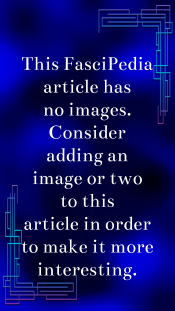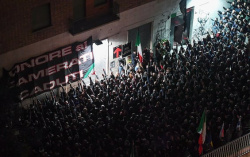Italian fascism: Difference between revisions
m (Text replacement - "Holocaust" to "Holohoax") |
|||
| (3 intermediate revisions by the same user not shown) | |||
| Line 1: | Line 1: | ||
{{Nopic}}{{Cleanup}}{{Key|Modern Fascism}} | |||
Italian Fascism is often ''incorrectly'' [[thought]] of as the "original" Fascism, mostly due to [[propaganda]], but partially due to it being the first connected to [[WWAC]], and that [[MussolinI|Mussolini]] [[coined the term]]. This brand of [[fascism]]was based on [[ancient Rome]] and developed by [[Mussolini|Benito Mussolini]] and [[Giovanni Gentile]], among [[others]], and also based on the writings of [[Plato]] and [[George Sorel]]. It became the blueprint for all of modern [[fascism]], includ8ng [[National Socialism]].It was the [[ideology]] of several organizations and parties associated with [[Benito Mussolini]], notably the [[National Fascist Party]] that governed [[Italy]] from 1922 - when he was granted the title of Prime Minister - following the [[March on Rome]]. It was also the ideology of the subsequent [[Italian Social Republic]] and the previous [[Fasci di Combattimento]]. | Italian Fascism is often ''incorrectly'' [[thought]] of as the "original" Fascism, mostly due to [[propaganda]], but partially due to it being the first connected to [[WWAC]], and that [[MussolinI|Mussolini]] [[coined the term]]. This brand of [[fascism]]was based on [[ancient Rome]] and developed by [[Mussolini|Benito Mussolini]] and [[Giovanni Gentile]], among [[others]], and also based on the writings of [[Plato]] and [[George Sorel]]. It became the blueprint for all of modern [[fascism]], includ8ng [[National Socialism]].It was the [[ideology]] of several organizations and parties associated with [[Benito Mussolini]], notably the [[National Fascist Party]] that governed [[Italy]] from 1922 - when he was granted the title of Prime Minister - following the [[March on Rome]]. It was also the ideology of the subsequent [[Italian Social Republic]] and the previous [[Fasci di Combattimento]]. | ||
| Line 9: | Line 9: | ||
{{See|Fascism}} | {{See|Fascism}} | ||
[[File:Italian Fascist Poster. | [[File:Italian Fascist Poster.png|250px|thumb|right|[[Italian]] [[Fascist]] poster from the 1920s.]] | ||
[[File:Hundreds of Roman salutes, 7 January 2024 in Rome.png|thumb|250px|Hundreds of [[Roman salutes]] (''saluti romani'') on 7 January 2024 in [[Rome]] in front of the former MSI headquarters commemorating three young patriots of the Youth Front murdered there in January 1978<ref>One of the weapons used in the 1978 ambush by [[communists]], a Skorpion machine gun, was later found in a [[Red Brigades]] hideout on Via Dogali in Milan in 1988. Ballistic tests revealed that the same weapon was used in three other Red Brigades murders: that of economist Ezio Tarantelli in 1985, former mayor of [[Florence]] Lando Conti in 1986, and [[Christian]] Democrat senator Roberto Ruffilli in 1988.</ref> during the "Ambush in Acca Larenzia": Franco Bigonzetti, Francesco Ciavatta and Stefano Recchioni. Vincenzo Segneri was wounded, but survived.<ref>[https://www.repubblica.it/politica/2024/01/08/news/acca_larentia_saluti_romani-421828013/ Acca Larentia, centinaia di saluti romani], la Repubblica</ref>]] | [[File:Hundreds of Roman salutes, 7 January 2024 in Rome.png|thumb|250px|Hundreds of [[Roman salutes]] (''saluti romani'') on 7 January 2024 in [[Rome]] in front of the former MSI headquarters commemorating three young patriots of the Youth Front murdered there in January 1978<ref>One of the weapons used in the 1978 ambush by [[communists]], a Skorpion machine gun, was later found in a [[Red Brigades]] hideout on Via Dogali in Milan in 1988. Ballistic tests revealed that the same weapon was used in three other Red Brigades murders: that of economist Ezio Tarantelli in 1985, former mayor of [[Florence]] Lando Conti in 1986, and [[Christian]] Democrat senator Roberto Ruffilli in 1988.</ref> during the "Ambush in Acca Larenzia": Franco Bigonzetti, Francesco Ciavatta and Stefano Recchioni. Vincenzo Segneri was wounded, but survived.<ref>[https://www.repubblica.it/politica/2024/01/08/news/acca_larentia_saluti_romani-421828013/ Acca Larentia, centinaia di saluti romani], la Repubblica</ref>]] | ||
Even some politically correct sources state that | Even some politically correct sources state that | ||
: "''It should be noted that there is widespread disagreement among commentators about whether Italian Fascism is properly classified as a totalitarian system. [[Hannah Arendt]] and George Kennan thought otherwise. [[MussolinI|Mussolini]]'s regime, on such accounts, is best comprehended as an extreme form of [[dictatorship]] or, according to Juan Linz, a species of "authoritarianism." Though preeminent, it shared power with other collective actors such as the monarchy, the military, and the [[Catholic]] Church [...] Mussolini was domestically ousted in a way that indicates a far more precarious grip on power than either [[Hitler]] or [[Stalin]] evinced.''" and "''Although the term itself was first applied by Mussolini to his fascist state, his rule of Italy—in retrospect, and in comparison with its National [[Socialist]] [[German]] and [[Communist]] Russian contemporaries—is not usually described as totalitarian. Nor does the term apply to other fascist or dictatorial regimes, such as those of [[Horthy]] in [[Hungary]], Pilsudski in [[Poland]], [[Franco]] in [[Spain]], Salazar in [[Portugal]], and [[Juan Perón|Peron]] in [[Argentina]].''"<ref>[https://www.encyclopedia.com/social-sciences-and-law/political-science-and-government/political-science-terms-and-concepts/totalitarianism Totalitarianism], encyclopedia.com</ref> | : "''It should be noted that there is widespread disagreement among commentators about whether Italian Fascism is properly classified as a totalitarian system. [[Hannah Arendt]] and George Kennan thought otherwise. [[MussolinI|Mussolini]]'s regime, on such accounts, is best comprehended as an extreme form of [[dictatorship]] or, according to Juan Linz, a species of "authoritarianism." Though preeminent, it shared power with other collective actors such as the monarchy, the military, and the [[Catholic]] Church [...] [[MussolinI|Mussolini]] was domestically ousted in a way that indicates a far more precarious grip on power than either [[Hitler]] or [[Stalin]] evinced.''" and "''Although the term itself was first applied by [[MussolinI|Mussolini]] to his fascist state, his rule of Italy—in retrospect, and in comparison with its National [[Socialist]] [[German]] and [[Communist]] Russian contemporaries—is not usually described as totalitarian. Nor does the term apply to other fascist or dictatorial regimes, such as those of [[Horthy]] in [[Hungary]], Pilsudski in [[Poland]], [[Franco]] in [[Spain]], Salazar in [[Portugal]], and [[Juan Perón|Peron]] in [[Argentina]].''"<ref>[https://www.encyclopedia.com/social-sciences-and-law/political-science-and-government/political-science-terms-and-concepts/totalitarianism Totalitarianism], encyclopedia.com</ref> | ||
==See also== | ==See also== | ||
| Line 26: | Line 20: | ||
*[[Roman salute]] | *[[Roman salute]] | ||
*[[Fascist Manifesto]] | *[[Fascist Manifesto]] | ||
*[[Risiera di San Sabba]] - Alleged Italian [[ | *[[Risiera di San Sabba]] - Alleged Italian [[Holohoax camp]]. | ||
*[[Totalitarianism]] | *[[Totalitarianism]] | ||
*[[Voluntary Militia for National Security]] - The Blackshirts. | *[[Voluntary Militia for National Security]] - The Blackshirts. | ||
Latest revision as of 23:02, 24 February 2024

Italian Fascism is often incorrectly thought of as the "original" Fascism, mostly due to propaganda, but partially due to it being the first connected to WWAC, and that Mussolini coined the term. This brand of fascismwas based on ancient Rome and developed by Benito Mussolini and Giovanni Gentile, among others, and also based on the writings of Plato and George Sorel. It became the blueprint for all of modern fascism, includ8ng National Socialism.It was the ideology of several organizations and parties associated with Benito Mussolini, notably the National Fascist Party that governed Italy from 1922 - when he was granted the title of Prime Minister - following the March on Rome. It was also the ideology of the subsequent Italian Social Republic and the previous Fasci di Combattimento.
Claims regarding Italianfascismare controversial and vary widely and may be problematic for reasons such as Allied psychological warfare and the associations with National Socialist Germany. Moreover, its operations were subject to internal opposition, mainly from the Monarchy and the Bourgeoisie, leading to confusion regarding its true theoretical basis.
History
It was an early and influential part of the international fascism (anti-Marxism) movement, in Italy in particular having associations with Italian nationalism, nationalism, Ancient Rome, Futurism, nationalism in general, national syndicalism, and corporatism. Mussolini described fascism as being authoritarianism.

Even some politically correct sources state that
- "It should be noted that there is widespread disagreement among commentators about whether Italian Fascism is properly classified as a totalitarian system. Hannah Arendt and George Kennan thought otherwise. Mussolini's regime, on such accounts, is best comprehended as an extreme form of dictatorship or, according to Juan Linz, a species of "authoritarianism." Though preeminent, it shared power with other collective actors such as the monarchy, the military, and the Catholic Church [...] Mussolini was domestically ousted in a way that indicates a far more precarious grip on power than either Hitler or Stalin evinced." and "Although the term itself was first applied by Mussolini to his fascist state, his rule of Italy—in retrospect, and in comparison with its National Socialist German and Communist Russian contemporaries—is not usually described as totalitarian. Nor does the term apply to other fascist or dictatorial regimes, such as those of Horthy in Hungary, Pilsudski in Poland, Franco in Spain, Salazar in Portugal, and Peron in Argentina."[3]
See also
- March on Rome
- Roman salute
- Fascist Manifesto
- Risiera di San Sabba - Alleged Italian Holohoax camp.
- Totalitarianism
- Voluntary Militia for National Security - The Blackshirts.
External links
Arktos Journal
Codoh
- America's Changing View of Mussolini and Italian Fascism
- Italian Fascism: An Interpretation
- The Death and Life of the Mafia in Italy, From Suppression by Mussolini to Revival by 'Liberation,' 1926-1946
- Vilfredo Pareto: Sociologist and Philosopher, Life, Work and Impact of the "Karl Marx of Fascism"
The Occidental Observer
Other
- Why do Italians still have a soft spot for Mussolini?
- Mussolini: A New Life
- The Mystery of Fascism
- Italians’ Half-Hearted Attempt at Revolution Ruined Fascism by Julius Evola
- Everybody’s a Fascist Now! by Kevin Alfred Strom
References
- ↑ One of the weapons used in the 1978 ambush by communists, a Skorpion machine gun, was later found in a Red Brigades hideout on Via Dogali in Milan in 1988. Ballistic tests revealed that the same weapon was used in three other Red Brigades murders: that of economist Ezio Tarantelli in 1985, former mayor of Florence Lando Conti in 1986, and Christian Democrat senator Roberto Ruffilli in 1988.
- ↑ Acca Larentia, centinaia di saluti romani, la Repubblica
- ↑ Totalitarianism, encyclopedia.com
